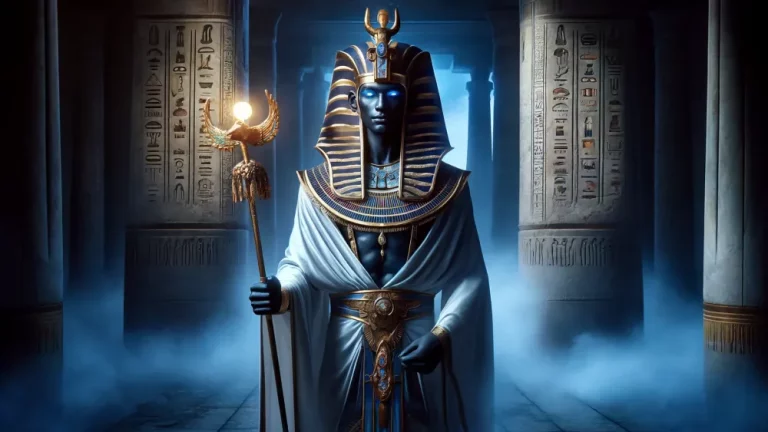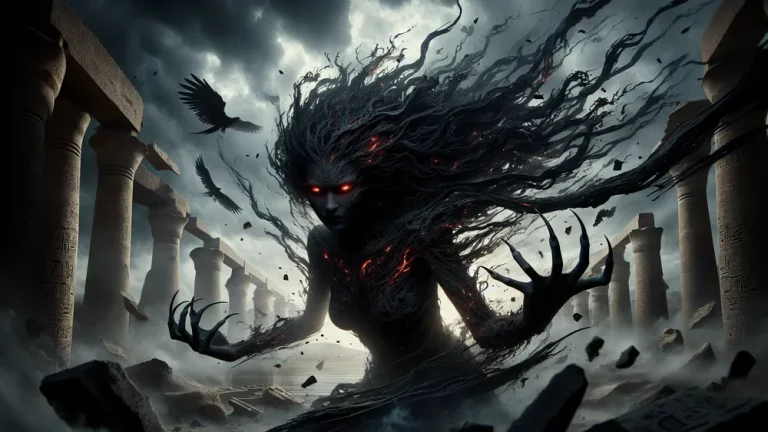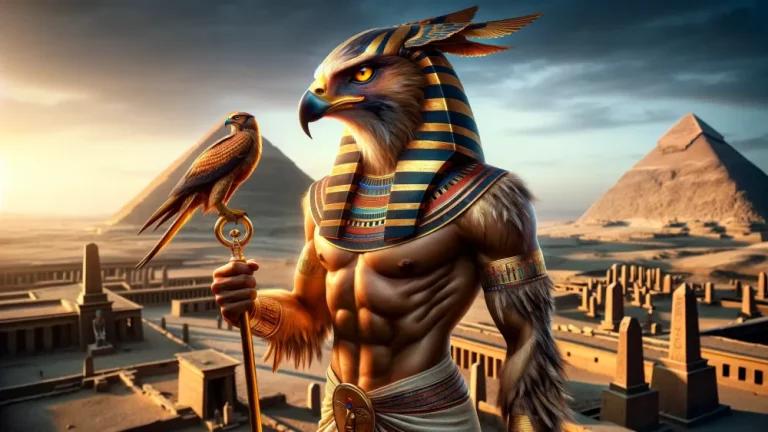The Labyrinth In Greek Mythology: Home Of The Minotaur
Among many amazing things in Greek mythology, the Labyrinth is known as one of the long-lasting, well-recognized creations, full of both wonder and sadness. It was built to keep the Minotaur, a creature that was part human and part bull, inside. The Labyrinth was not only a prison.
Key Points:
- The Labyrinth was created by Daedalus for King Minos to trap the Minotaur, born from divine punishment.
- The Minotaur, a mix of man and bull, came from Queen Pasiphaë’s unnatural union with a bull, set in motion by Poseidon’s curse.
- Theseus, a hero of Athens, killed the Minotaur with Ariadne’s help, using a thread to navigate the maze and a sword to defeat the beast.
- The Labyrinth stood for struggles in life, combining chaos and order, and the idea of overcoming what feels like destiny.
- Its myth connects strongly to the real palace of Knossos in Crete, symbolizing the blend of mystery and human ingenuity.
- Ancient Greek art, like vases and mosaics, often retold this myth, showing scenes from the maze and Theseus‘ fight with the Minotaur.
- Daedalus, the creator, was also the mind behind other notable inventions but suffered from his own brilliance.
It was proof of human skill and a sign of the gods’ punishment. The maze was designed by Daedalus, a famous craftsman, because King Minos of Crete wanted something that could trap the unusual creature, which had been born as a result of his own actions defying the gods’ rules. But the Labyrinth is more meaningful than its dark mission. It explains the old human battle to try to organize the disorder around us.
This struggle is visible in the detailed design of the maze and how hard it was to solve. The maze, much like a really hard problem, is both an amazing piece of work and almost impossible to solve. It stands as a mix of creativity and destruction, control and disorder, all at once.
For the people of ancient Greece, and even for those who came after them, it was not simply a mythical spot. It also became a deep symbol connected to life. The story of the Labyrinth includes some of the most important characters of mythology, such as Daedalus and Theseus, and even the heartbreaking story of the Minotaur.
To figure out what the Labyrinth truly means, it is necessary to jump deeper into the stories and lessons hidden inside its history, which we will look at more closely in the next parts.
The Labyrinth: Overview and Key Facts
| Main Element | Details |
|---|---|
| What It Was Called | The Labyrinth |
| Why It Was Built | It was created to trap and hold the Minotaur, a half-human and half-bull creature that came to exist because of a divine punishment. |
| Where It Was Found | Said to be on Crete, an island, often tied to the palace at Knossos, which is an actual place archaeologists have studied. |
| Who Made It | Daedalus, who was an incredibly skilled craftsman, is the one who built it. |
| Who Asked For It | King Minos of Crete, who wanted a way to control the terrible Minotaur, which was born as a result of his wife Pasiphaë’s curse from the gods. |
| What It Was Like | A maze so complicated that even the people stuck in it or the man who made it couldn’t escape easily. |
| What It Meant in Myth | The Labyrinth stood for two ideas: humans can build amazing things while also dealing with the downside of defying the gods. |
| When It First Showed Up | It first appears in old Greek stories, like the one about Theseus and the Minotaur. Ancient writers like Hesiod talked about it, and it was later included in Roman works, like Ovid’s Metamorphoses. |
| Why It Matters | Seen as a symbol of human struggles, difficult challenges, and tough choices, the Labyrinth inspired people in art, books, and even philosophy both in the ancient days and after. Its myth kept people curious forever. |
How the Labyrinth Came to Be
To understand how the Labyrinth began, it is important to look at the people, the choices, and the events that made it possible. From the clever designer Daedalus, who created it, to the grim reason it was made, the Labyrinth’s story combines many ideas. It mixes art, punishment, and a terrible destiny into one single creation.
Now, we will see how mythology explains these things together and how they led to the beginning of one of its most famous myths.
Who Built the Labyrinth, and What Was It For?
Among the many famous creations in Greek mythology is the Labyrinth, which was built by Daedalus, a highly skilled builder and inventor. King Minos of Crete asked for it to be built because he needed a way to trap the Minotaur, a terrifying creature born from a god-given curse placed on Minos and his family.
It was made for this grim and important reason: to create a place where the monster could be kept, and where no escape would be possible. The Labyrinth itself was designed to be so confusing and so complicated that no one could figure out how to get out.
Not even Daedalus, the person who made it, was able to find his way back once he entered it, which proves how incredibly skilled he was at building. Its design stood for getting lost and feeling trapped, made to ensure that the Minotaur – and anyone unlucky enough to be sent there – would stay in its endless corridors forever.
If you think about why it was created, the Labyrinth wasn’t only built to hold a monster. It also explains how King Minos tried to take control of the punishment given to him by the gods. The monster was born because of Minos’s defiance, but the Labyrinth became a way to deal with both the divine punishment and the fearsome creature.
It combined amazing skill with the darker side of what humans can make when power and control are the main goals.
The Labyrinth, created by Daedalus at King Minos’s command, was a complex maze built to imprison the Minotaur and symbolized human attempts to control divine punishment through ingenuity and power.
Daedalus: The Mind Behind the Maze
Daedalus was one of the most famous builders and inventors in Greek myths. Known for how skilled and inventive he was, his life was filled with both brilliance and tragedy. King Minos of Crete asked Daedalus to create the Labyrinth, which was a large and confusing structure built to trap the Minotaur. The Labyrinth was made so cleverly that even Daedalus, the one who designed it, had trouble finding his way through it.
But the things Daedalus created went far beyond just the Labyrinth. Stories say that he made tools, statues that looked almost alive, and even early versions of machines. However, the genius of Daedalus often got overshadowed by the problems his actions caused. For example, he made the wooden cow that helped Queen Pasiphaë, which led to the birth of the Minotaur.
Because Minos thought Daedalus had betrayed him, he put Daedalus and his son Icarus in prison. While in captivity, Daedalus made wings from feathers and wax so they could escape. This invention worked, but it led to a tragedy: Icarus flew too close to the sun, which melted the wax, and he fell to his death.
The myths about Daedalus explain two things: one, he was incredibly creative, and two, his story reveals how human innovation can sometimes cause harm when it is used without limits. His life was a balance of both success and warning, and this is why Daedalus is such an essential part of the story of the Labyrinth.
How the Minotaur Came into the Picture
The story of the Minotaur begins with Poseidon, a powerful sea god, and a white bull sent to King Minos as a sign of approval from above. Minos, who ruled Crete, had asked Poseidon to prove that he deserved to be king. Poseidon sent a special bull from the ocean, but with one condition: Minos had to sacrifice it as an offering to honor Poseidon’s role in his success.
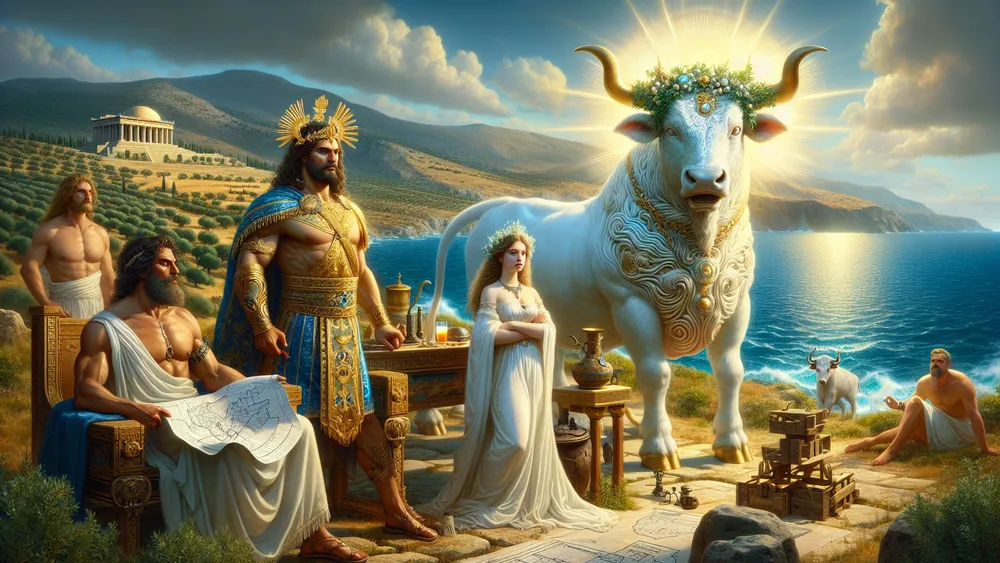
However, instead of sacrificing the bull, Minos chose to keep it. He admired it too much and decided to offer a less important bull instead. When Poseidon found out, he became furious and punished Minos in a way that hurt his entire family. As part of this punishment, Poseidon placed a strange and unnatural desire in Queen Pasiphaë.
She suddenly felt an unexplainable longing for the bull. In some versions of the story, this curse embarrassed Minos and served as a warning about what happens when humans defy the gods. Pasiphaë, affected by the curse, asked the inventor Daedalus to create something for her. She wanted a way to fulfill her unnatural desire for the bull.
Daedalus built what might be one of his most disturbing creations – a wooden cow covered in real cow skin. Pasiphaë hid in this hollow cow to get close to the bull. From this bizarre act, the Minotaur was born.
This strange creature, with the body of a man and the head of a bull, stood as a powerful reminder of the gods’ anger and how dangerous human arrogance can be. Known as Asterion in some stories, the Minotaur was seen as both a danger and a symbol of divine punishment.
Since it was born from something so unnatural, the Minotaur became a secret of Minos’ royal family and was locked away in the Labyrinth, another creation of Daedalus.
- Key Events That Led to the Minotaur:
- Poseidon’s Anger: Minos did not offer the bull as Poseidon demanded, which started the curse.
- Pasiphaë’s Curse: The queen became affected by a strange desire for the bull.
- Daedalus’ Wooden Cow: A strange invention that allowed the curse to be fulfilled.
- The Creation of the Minotaur: A creature born from this act, representing divine punishment and human arrogance.
The Story of Theseus and the Minotaur
The Minotaur had been trapped inside the Labyrinth, a maze so vast and confusing that it seemed impossible to escape. And now, the story turns to focus on a young hero: Theseus. His bravery and actions during this time would connect his fate to both the terrible creature and the maze where it was held.
It is time to look closer at what happened in this famous story.
Theseus’ Path to Becoming a Hero
The story of Theseus begins with his two roles as the son of Aegeus, the King of Athens, and Aethra, a mortal woman who raised him without revealing his father’s identity until he was old enough to understand. Athens at the time was going through tough times under the harsh demands of King Minos of Crete. This all started when Minos’ son, Androgeus, died in Athens while competing in some games.
Furious, Minos took revenge by forcing the city to send seven young men and seven young women every nine years to Crete. Once there, they were sacrificed to the Minotaur, a brutal creature locked inside the Labyrinth. Determined to save his people, Theseus decided he would go as one of these offerings.
His father, Aegeus, tried to stop him, fearing he might never come back, but Theseus was set on ending this terrible tradition. This choice showed his sense of duty to his people, along with the courage that would later define him as a hero. When Theseus left for Crete, most believed he would die.
But he promised his father one thing: if he survived, he would replace the black sail on the returning ship with a white sail as a sign of victory. Sailing toward Crete, Theseus proved he wasn’t just a victim. He was ready to fight back against the Minotaur and break Athens’ cycle of sacrifices.
Even though everyone thought this was a hopeless mission, his actions – fueled by courage and a willingness to risk everything – made him stand out as an example of a classic Greek hero.
Ariadne’s Plan to Save Theseus
Ariadne, the daughter of King Minos and Queen Pasiphaë, was a key reason why Theseus survived his encounter with the Minotaur. She fell in love with him soon after he arrived in Crete. Because she knew it would be impossible to get through the Labyrinth without help, Ariadne created a plan that would give him a chance to live.
She handed him a ball of thread – a simple tool he could use to leave a trail behind him as he went into the maze. This thread, which some people call a “clew,” gave him a way to find his way out after facing the Minotaur.
To help even more, Ariadne gave Theseus a sword, knowing he would need a weapon to fight the beast. Once the Minotaur was defeated, Theseus followed the trail of thread to escape the maze. Afterward, Ariadne helped him leave Crete by taking him to a ship waiting nearby, which she seems to have arranged in secret.
Ariadne’s help can be summed up in these key ways:
- Thread: This let Theseus find his way out of the maze after completing the mission.
- Sword: A weapon Theseus used to fight and defeat the Minotaur.
- Escape: Ariadne got Theseus safely away from Crete after his victory.
Ariadne ensured Theseus survived the Labyrinth and escaped Crete by giving him a thread to retrace his steps, a sword to defeat the Minotaur, and arranging his secret departure.
Taking Down the Minotaur
Deep inside the twisting pathways of the Labyrinth, Theseus finally encountered the Minotaur. This frightening creature had the body of a man and the head of a bull. Stories from ancient writers often say the fight was harsh and full of tension, with nothing but silence surrounding them in the maze. Theseus had a sword, which Ariadne had given him, and he used it along with his wits.
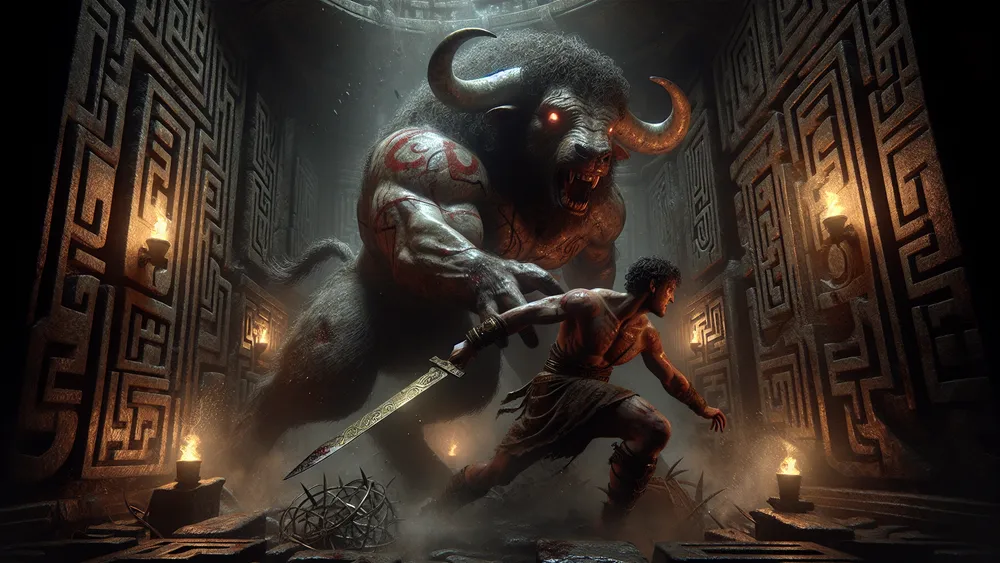
He understood that raw strength might not win this battle. The creature’s violent behavior and the small space made the fight even more dangerous than it already was. With one well-aimed strike, Theseus killed the Minotaur. The long years of suffering for the young people sent to Crete as sacrifices were now over. Different versions of the story add varying details.
Some focus on how brave Theseus was, while others point out how smart he needed to be. But in the end, the outcome is always the same: the terrible symbol of King Minos’ rule was destroyed, and the hero of Athens returned victorious.
What the Labyrinth Means
The well-known story of Theseus and the Minotaur is just one part of what the Labyrinth represents. There is much more to consider. Its real importance comes from the deeper ideas connected to its design and the creatures found inside it. Now, let’s take a closer look at why the Labyrinth matters, both in myths and in other contexts.
The Labyrinth as a Puzzle About Life | 1.5
The Labyrinth is often seen as a way to understand life. Its twisting, complicated paths stand for the journey each person makes to learn more about themselves or reach understanding. Similar to life, the Labyrinth demands that a person stay determined, figure things out, and think clearly to get through it.
This idea isn’t new – it has always shown how people deal with problems and uncertain moments in their lives. Its detailed structure also stands for the constant pull between chaos and order. With no simple, clear route to follow, the Labyrinth reminds us how people are always trying to create meaning and structure in a world that feels unpredictable.
At the same time, the Labyrinth brings up another idea: the clash between free will and fate. It is meant to trap whoever enters. But Theseus proves that, even in the toughest situations, clever planning and determination can beat what seems like an impossible challenge.
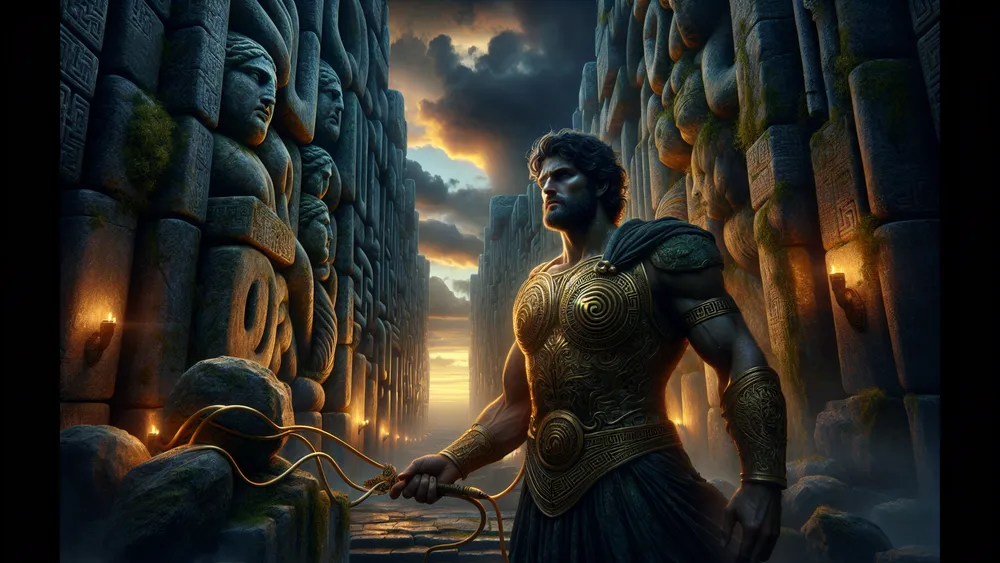
| Symbolism | What It Means |
|---|---|
| Life’s journey | The Labyrinth’s twisting paths stand for the struggles and lessons people face in life. |
| Chaos and order | The maze’s design shows the constant pull between disorder and the need for structure. |
| Overcoming fate | The Labyrinth is a trap, but Theseus proves that huge obstacles can still be beaten. |
The Minotaur: A Mix of Human and Monster
The Minotaur came into existence because of punishment from the gods and mistakes made by humans. It has often been seen as a symbol of how humans are both thoughtful and wild. With a man’s body and a bull’s head, the Minotaur looked like a mix of being civilized and being wild.
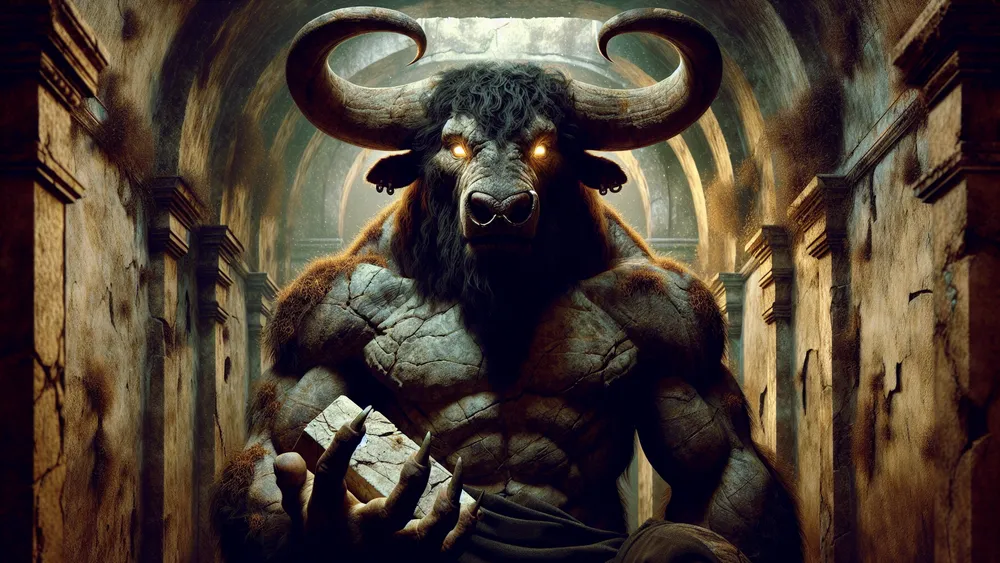
This mix reflected how people in ancient Greece thought about the thin line between human thought and animal instincts. The Minotaur wasn’t just a creature stuck in a maze. The Labyrinth trapping it also reminds us of how people can feel trapped inside themselves: by their wild thoughts or by desires they can’t control.
Different myths tell the story of the Minotaur in different ways. Some say it was a predator with no real thoughts – only a creature focused on eating its victims. Others describe it as something sad, something cursed to be an outcast just because it was born in a way that wasn’t natural. Whichever version you look at, the Minotaur means more than fear.
It also means struggles that humans feel in themselves, trying to balance their reasoning and their chaos.
How Ancient Greeks Saw the Labyrinth
Outside of its mythical stories and the meanings people gave it, the Labyrinth existed as more than just legend. It was a strong idea that stayed important in the everyday life and art of ancient Greece. Now, let’s take a closer look. The Greeks expressed and worked with this famous structure in many ways.
The Labyrinth in Ancient Greek Art
The Labyrinth myth, along with the story of the Minotaur, had a big impact on the art of ancient Greece. You can see it in pottery, mosaics, and statues. One famous example is the Minotaur Vase from Athens. It’s from around the 6th century BCE. The vase shows Theseus fighting the Minotaur.
It works as both a way of telling the story and as a sign of how proud Athenians were of Theseus and what he did. There were also mosaics that used detailed patterns. These patterns stood for how complicated the Labyrinth was. Some can still be found today in Roman houses that were influenced by earlier Greek designs.
Statues and carvings also focused on moments from this myth. One theme often repeated? The moment when Theseus kills the Minotaur. You can see this in carvings on stone or big statues. These pieces make the story of the hero and the beast feel real.
- The Minotaur Vase (6th century BCE): A vase from Athens that shows Theseus battling the Minotaur and highlights his bravery.
- Mosaics: Patterns that stand for the Labyrinth’s complexity, seen in Roman villas and based on earlier designs from Greece.
- Sculptures: Statues of the fight between Theseus and the Minotaur, focusing on struggle and triumph.
Where Was the Labyrinth in Myth?
In Greek myths, the Labyrinth was said to be on the island of Crete, placed beneath the palace of King Minos. Many versions of the story place it near Knossos, which was the heart of the strong Minoan civilization. This connection between the mythical Labyrinth and Knossos comes from the real palace there.
The palace is large and complicated, and its layout made it easy for people to imagine it as the real version of the maze from the story. The Labyrinth itself, in the myth, was said to have been crafted by Daedalus. He was known as a person of extraordinary skill, and the myth says his work made the Labyrinth something magical.
On the other hand, ideas about Knossos as a critical and advanced place helped connect the two together in people’s minds. This combination of myth and real history played a major role in how ancient people thought about the world. Stories like the Labyrinth helped them link big myths to places they knew.
For those interested in exploring more locations tied to myths, this Greek Geographical Concepts list offers an overview of places where myth and reality meet together.
FAQs
1. Was the Minotaur a punishment from Poseidon?
The Minotaur was indeed a punishment from Poseidon, stemming from King Minos’ refusal to sacrifice the divine bull as originally promised.
2. Why couldn’t Daedalus escape the Labyrinth immediately?
Daedalus couldn’t escape the Labyrinth immediately because its design was so intricate and disorienting that even its creator could not easily navigate it.
3. What role did Ariadne play in Theseus’ victory?
The role Ariadne played in Theseus’ victory involved providing him with a thread and a sword to navigate the Labyrinth and slay the Minotaur.
4. How does the Labyrinth connect to Crete’s mythology?
The Labyrinth connects to Crete’s mythology as a symbol of the island’s mythical grandeur, linking the Minotaur, King Minos, and the palace of Knossos to its legendary cultural and divine heritage.

